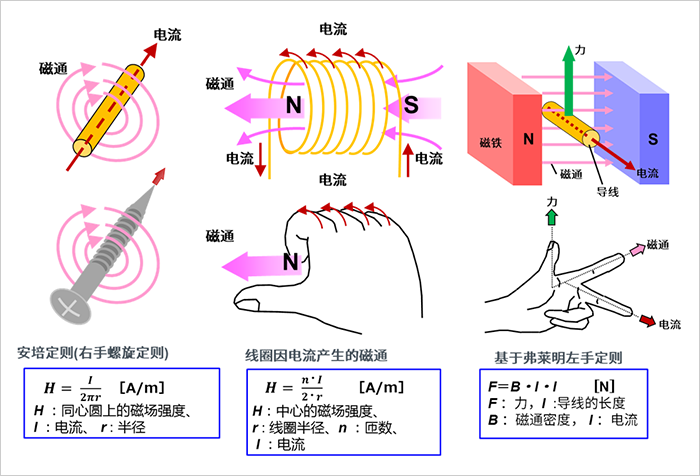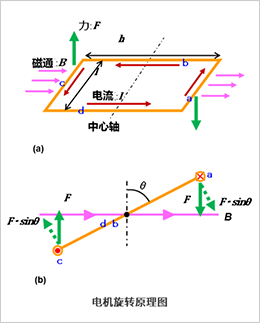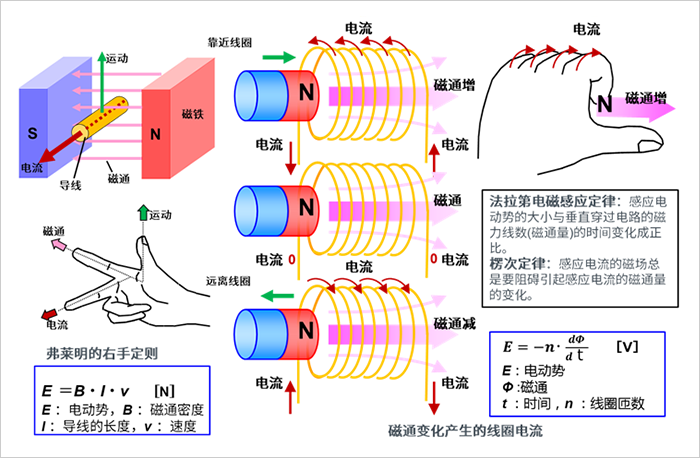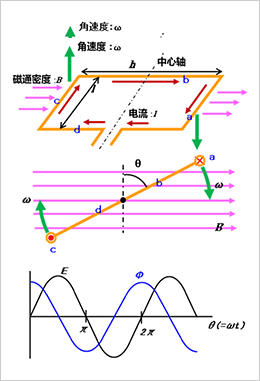Electric current, magnetic field and force
First, for the convenience of subsequent motor principle explanations, let’s review the basic laws/laws about currents, magnetic fields, and forces. Although there is a sense of nostalgia, it is easy to forget this knowledge if you don’t use magnetic components often.
Detailed explanation of the principle of rotation
The rotation principle of the motor is described below. We combine pictures and formulas to illustrate.
When the lead frame is rectangular, the force acting on the current is taken into account.
The force F acting on the parts a and c is:
Generates torque around the central axis.
For example, when considering the state where the rotation angle is only θ, the force acting at right angles to b and d is sinθ, so the torque Ta of part a is expressed by the following formula:
Considering part c in the same way, the torque is doubled and yields a torque calculated by:
Since the area of the rectangle is S=h·l, substituting it into the above formula yields the following results:
This formula works not only for rectangles, but also for other common shapes like circles. Motors use this principle.
The principle of rotation of a motor follows the laws (laws) related to currents, magnetic fields and forces .
The power generation principle of the motor
The power generation principle of the motor will be described below.
As mentioned above, a motor is a device that converts electrical energy into power, and can achieve rotational motion by exploiting the force created by the interaction of a magnetic field and an electric current. In fact, conversely, the motor can also convert mechanical energy (motion) into electrical energy through electromagnetic induction. In other words, the motor has the function of generating electricity. When you think of generating electricity, you probably think of generators (also known as “Dynamo”, “Alternator”, “Generator”, “Alternator”, etc.), but the principle is the same as that of electric motors, and the basic structure is similar. In short, a motor can obtain rotational motion by passing current through the pins, conversely, when the motor’s shaft rotates, current flows between the pins.
The power generation function of the motor
As mentioned earlier, the power generation of electric machines relies on electromagnetic induction. Below is an illustration of the relevant laws (laws) and the role of power generation.
The diagram on the left shows that current flows according to Fleming’s right-hand rule. By the movement of the wire in the magnetic flux, an electromotive force is generated in the wire and a current flows.
The middle diagram and the right diagram show that according to Faraday’s law and Lenz’s law, current flows in different directions when the magnet (flux) moves closer to or away from the coil.
We will explain the principle of power generation on this basis.
Detailed explanation of power generation principle
Suppose a coil of area S (=l×h) rotates at an angular velocity of ω in a uniform magnetic field.
At this time, assuming that the parallel direction of the coil surface (yellow line in the middle figure) and the vertical line (black dotted line) with respect to the direction of the magnetic flux density form an angle of θ (=ωt), the magnetic flux Φ penetrating the coil is given by the following formula express:
In addition, the induced electromotive force E generated in the coil by electromagnetic induction is as follows:
When the parallel direction of the coil surface is perpendicular to the magnetic flux direction, the electromotive force becomes zero, and the absolute value of the electromotive force is the largest when it is horizontal.
Post time:
Oct-05-2022









